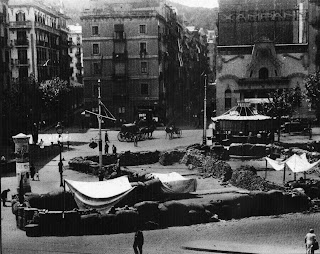From the plan of the shelter, it seems that this little construction,
further up the road, is one of the original entrances. Of the other, in
front of carrer Magalhäes (Magallanes), there is no trace.
Monday 30 April 2007
Surviving Entrance.
Publicado por
Valerie
0
comentarios
![]()
Etiquetas: Refugi307 - Air Raid Shelter 307
Friday 27 April 2007
More Truth and Lies
THE TRAGEDY OF GUERNICA
TOWN DESTROYED IN AIR ATTACK
From Our Special Correspondent
Bilbao, April 27
and the centre of their cultural tradition was
completely destroyed yesterday afternoon by
insurgent air raiders. The bombardment of
this open town far behind the lines occupied
precisely three hours and a quarter, during
which a powerful fleet of aeroplanes consisting
of three German types, Junkers and Heinkel
bombers and Heinkel fighters, did not cease
unloading on the town bombs weighing from
1000lb downwards and, it is calculated, more
than 3000 two-pounder aluminium incendiary
projectiles. The fighters, meanwhile, plunged
low from above the centre of the town to
machine-gun those of the civilian population
who had taken refuge in the fields.
The whole of Guernica was soon in flames.
The Times 28th April 1938
"LIES, LIES, LIES."
Radio Nacional. Salamanca.
THE BURNING OF GUERNICA
The Nationalist Army is in control of Guernica.
Better said, in control of what remains of Guernica,
the town which the red hordes, in sinister collusion
with Aguirre´s separatists, have left in ruins.
ABC 30th April 1938
Publicado por
Valerie
0
comentarios
![]()
Thursday 26 April 2007
Control
Anarchist barricades in Paral.lel, the main road down to the port,
Poble Sec July 1936
So the neighbours were right. The shelter was much bigger than
the 30 or so metres (marked in red on the plan below) I had
photographed. 3 entrances (though one section of the tunnels
seemed to be separate from the rest), 6 toilets... And, according
to my neighbours, excavated by hand by the people who had
lived in my street.
The strange thing was the date: 17th February 1939. Barcelona
had fallen to Franco's troops on the 26th of January and plans
of other shelters published in Estanislau Roca's book were all
dated from during the war.
But, of course, it turned out the plans had been drawn up by the
fascists. Underground tunnels have subversive possibilities.
Especially in what had been one of the anarchist strongholds
during the war.
I have great taste in Barrios.
Publicado por
Valerie
0
comentarios
![]()
Etiquetas: Refugi307 - Air Raid Shelter 307
Tuesday 17 April 2007
The Book
Josep Canós, my student, lent me the book.
"Montjuïc, la Muntanya de la Ciutat."
by Estanislau Roca i Blanch.
Boxed, black, cloth-bound, beautiful.
With the map of my air raid shelter.
Publicado por
Valerie
0
comentarios
![]()
Etiquetas: Refugi307 - Air Raid Shelter 307
Sunday 8 April 2007
Information

The Catalans do beautiful things with bricks.
This building, designed by Pere Falqués and dating from 1897,
is on old power station. Lovingly preserved and converted into
company headquarters, in 1995 it belonged to Hidroelèctrica de
Catalunya, one of the Catalan electricity companies.
It was here that I got some help about how to find information
on the shelter.
I had gone back upstairs after that first exploration and picked up
the phone, angry that this silent, yet totally eloquent, witness to
the reality of war should be in such a state of abject abandon.
The Barcelona History Museum had no information and wasn't
sure where I could find any.
A little surprising.
More so as it turned out that a large part of the existing
documentation is held in municipal archives.
They did suggest, however, that I contact their Archaeology
Department and gave me a name and a number. The archaeologists
couldn´t help on the documentation either but, at least, promised
to come and look at the shelter.
I spent the weekend phoning people I knew who had some interest
in history. Most knew little or nothing but, coincidentally, two of
my students (I teach English) at the electricity company provided
some valuable information.
One remembered an article in the newspaper El Pais from the
previous year. A large underground shelter had appeared (briefly),
disappeared (rapidly) and reappeared (irrevocably) as a new car park.
He also suggested I contact a journalist called Huertas Claveria at
El Periódico.
The other said he thought a book he had about the history of Montjuïc
mentioned air raid shelters.....
His wife, an architect, had worked on some of the '92 Olympic
installations. The book, written by her boss and published by a
company that has been getting rich exploiting the mountain in one
way or another for over a hundred years, was a special edition, a gift
for the chosen, and not for sale to the public.
Can he check, please?
I wait while he gets the book.
"Yes, there's a section on civil defence and some plans of shelters
here. One from your street."
This is after all the negatives is incredible, it seems the book has a
plan of the shelter I have found.
He promises to lend me the book.
He also suggests I contact a journalist called Lluis Permanyer at La Vanguardia.
Publicado por
Valerie
0
comentarios
![]()
Etiquetas: Refugi307 - Air Raid Shelter 307
Friday 6 April 2007
Mariana had been worried about rats.
I about getting buried alive.
What we weren't prepared for were the tons of rubble blocking the end of the tunnel.
Publicado por
Valerie
0
comentarios
![]()
Etiquetas: Refugi307 - Air Raid Shelter 307
Wednesday 4 April 2007
Neighbours had assured me that the shelter was very big
and even to my inexperienced eye it looked as if it had been
walled up at the point where the tunnel came to an abrupt end.
Publicado por
Valerie
0
comentarios
![]()
Etiquetas: Refugi307 - Air Raid Shelter 307
Comparisons.


macksites.com images
Let me remind you of that great British invention:
The Anderson Shelter.
2,250,000 of which were distributed before and during World War II for installation in that other great British invention:
The Back Garden.
If you had one.
6 ft. 6 in. by 4 ft. 6 in. of corrugated iron
You will perhaps understand why I was impressed.
Publicado por
Valerie
0
comentarios
![]()
Etiquetas: Refugi307 - Air Raid Shelter 307






